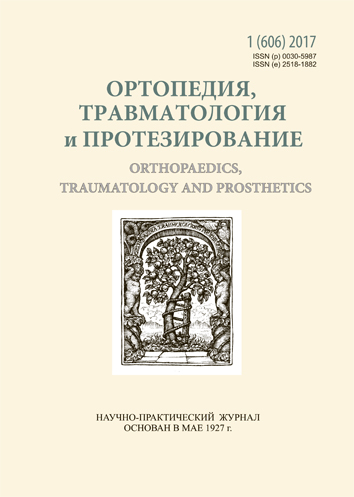Stress-strain state of proximal femur after joint arthoroplasty with neck defect conditions at the minor trochanter level with different stem types
DOI:
https://doi.org/10.15674/0030-59872017134-38Keywords:
mathematical models, phases of movement, hip joint, endopros¬thetics, types of fixation of the endoprosthesis stemsAbstract
In the primary hip arthroplasty, the metaphyseal fixation type stems have proved to be very useful, allowing the stability of the fixation and the diaphyseal section of the femur to remain stable for future revision surgeries. However, with the increase in the defect of bone tissue as a result of trauma, it becomes necessary to use the stems of a second type of fixation.
Purpose: to investigate the stress-strain distribution of the proximal femur in conditions of arthroplasty with stems of various types of fixation in case of defect of the femoral neck at the level of a minor trochanter.
Methods: using the finite element method, the pelvic and hip joints were modeled in various phases of walking. The model included the endoprosthesis «Zimmer» installed in the left hip joint in two versions — with metaphyseal and diaphyseal stems fixation types.
Results: stress-strain distribution of the proximal femur in conditions of endoprosthetics with a femoral neck defect at the level of a minor trochanter was different for variants of the model with diaphyseal and metaphyseal stem fixation in all phases of the movement. The stress-strain data for the version of the model with the metaphysical fixation stem almost always exceeded the values obtained with the diaphysial type of fixation. The greatest difference was found for the first and third phases of movement in the upper third of the medial surface of the femur at the site of contact with the endoprosthesis.
Conclusions: in the case of a femoral neck defect at the level of a minor trochanter in conditions of endoprosthetics, it is necessary to give preference to the use of an endoprosthesis with a diaphysial fixation stem.References
- Archibeck MJ, Carothers JT, Tripuraneni KR, White RE Jr. Total hip arthroplasty after failed internal fixation of proximal femoral fractures. J Arthroplasty. 2013;28(1):168–71. doi: 10.1016/j.arth.2012.04.003.
- Leonardsson O, Rogmark C, Kärrholm J, Akesson K, Garellick G. Outcome after primary and secondary replacement for subcapital fracture of the hip in 10 264 patients. J Bone Joint Surg Br. 2009;(5):595–600. doi:10.1302/0301-620X.91B5.22224.
- Exaltacion JJ, Incavo SJ, Mathews V, Parsley B, Noble P. Hip arthroplasty after intramedullary hip screw fixation: a peri¬operative evaluation. J Orthop Trauma. 2012;26(3):141–7. doi: 10.1097/BOT.0b013e318221ea6b.
- Mabry TM, Prpa B, Haidukewych GJ, Harmsen WS, Berry DJ. Long-term results of total hip arthroplasty for femoral neck fracture nonunion. J Bone Joint Surg Am. 2004;86-A(10):2263–67.
- Schwarzkopf R, Manzano G, Woolwine S, Slover J. Salvage treatment of hip fractures after failure of surgical fixation: a systematic review. Orthopaedic Knowledge Online Journal. 2015;13(3). doi:10.5435/OKOJ-13-3-3.
- Filipenko VA, Zlatnyk RV, Bondarenko SE, Akonjom M. Features of radiological and anatomical changes in bone of the hip joint due to injuries. Orthopaedics, Traumatology and Prosthetics. 2015;3:55-60. doi: 10.15674/0030-59872015355-60. (in Ukrainian)
- Vidalain JP. Twenty-year results of the cementless Corail stem. Int Orthop. 2011;35(2):189–94. doi:10.1007/s00264-010-1117-2.
- Mastering orthopedic techniques: Total hip arthroplasty. Ed. by Malhotra Rajesh. 1st edition. New Delhy: Jaypee brothers medical publishers (P) LTD, 2012. 640 p.
- Tyazhelov ОA, Filipenko VA, Yaresko ОV, Bondarenko SE. A mathematical model of the pelvis for calculation of its stress-strain state. Orthopaedics, Traumatology and Prosthetics. 2015;(1):25-33 doi: 10.15674/0030-59872015125-33. (in Russian)
- Filipenko VA, Tankut VA, Bondarenko SYe, Staude VA, Yaresko АV, Akonjom M. Stress-strain state of pelvis and hip models on different phases of step. Orthopaedics, Traumatology and Prosthetics. 2015;(4):31–6. doi: 10.15674/0030-59872015431-36. (in Russian)
- Gruen TA, McNeice GM, Amstutz HC. «Modes of failure» of cemented stem-type femoral components. Clin Orthop Relat Res. 1979;141:17–27.
Downloads
How to Cite
Issue
Section
License
Copyright (c) 2017 Volodymyr Filipenko, Stanislav Bondarenko, Tankut Volodymyr, Anatoliy Zhygun, Oleksandr Yaresko

This work is licensed under a Creative Commons Attribution 4.0 International License.
The authors retain the right of authorship of their manuscript and pass the journal the right of the first publication of this article, which automatically become available from the date of publication under the terms of Creative Commons Attribution License, which allows others to freely distribute the published manuscript with mandatory linking to authors of the original research and the first publication of this one in this journal.
Authors have the right to enter into a separate supplemental agreement on the additional non-exclusive distribution of manuscript in the form in which it was published by the journal (i.e. to put work in electronic storage of an institution or publish as a part of the book) while maintaining the reference to the first publication of the manuscript in this journal.
The editorial policy of the journal allows authors and encourages manuscript accommodation online (i.e. in storage of an institution or on the personal websites) as before submission of the manuscript to the editorial office, and during its editorial processing because it contributes to productive scientific discussion and positively affects the efficiency and dynamics of the published manuscript citation (see The Effect of Open Access).














